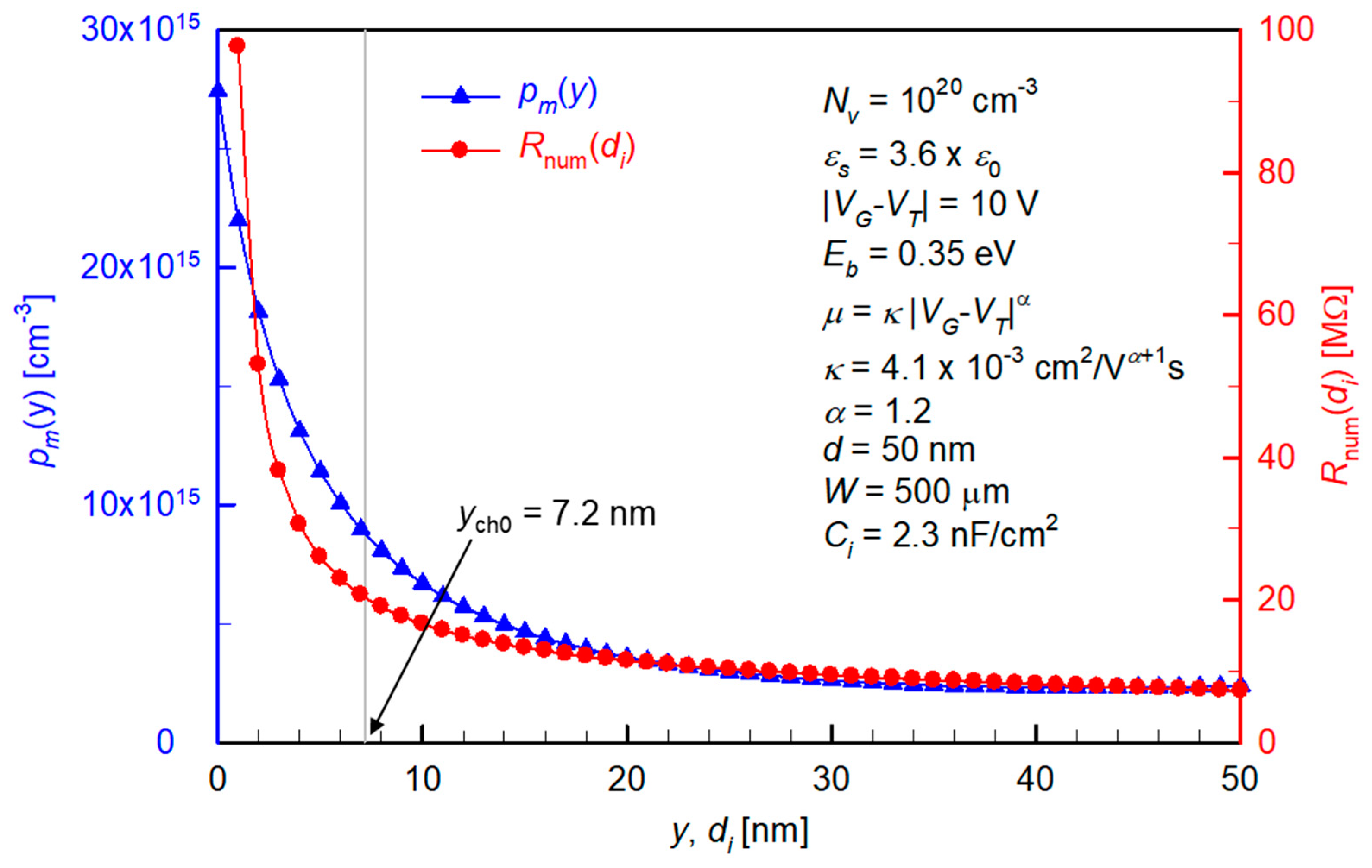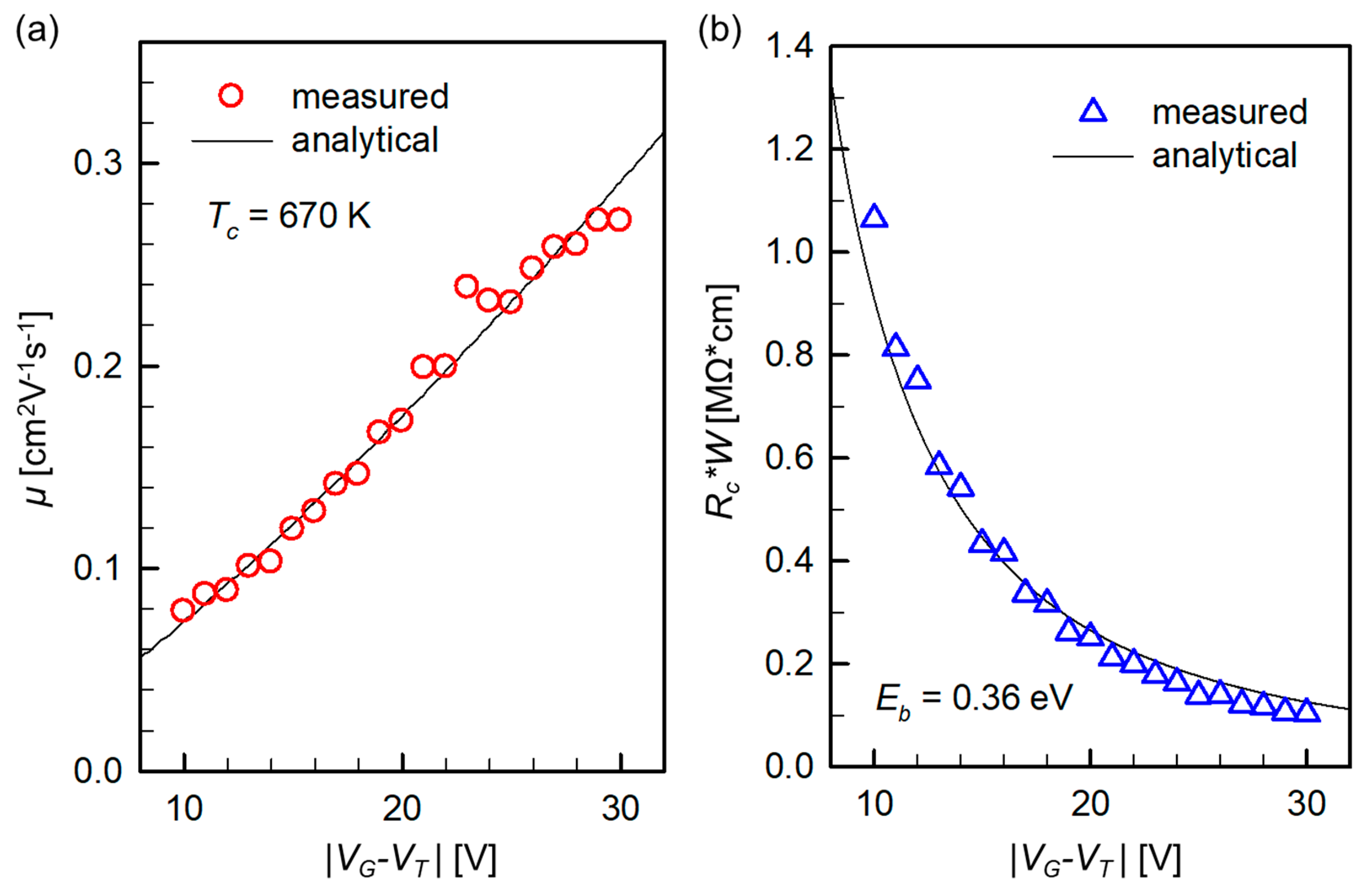Toward a Fully Analytical Contact Resistance Expression in Organic Transistors
Abstract
:1. Introduction
2. Theoretical Modeling
- (1)
- Here, both pm and Rnum decrease rapidly when moving from the insulator (y, di = 0) to the top surface of the semiconductor (y, di = 50 nm). Therefore, we choose to consider only the region 0 < y < ych0, with the ych0 being the effective accumulation thickness from the Mott–Gurney distribution. The value of ych0 therefore decreases when VG increases (in magnitude) showing a smaller geometrical spread of the carriers at a higher gate field.
- (2)
- In order to replace an integral with a simpler multiplication, we now need to deal with those that change with y in Equation (5), namely pm(y) and t(y). There are different ways to do this. For maximum simplicity, we take pm0 and t0 as the representative values that are determined by ps0 and pch0, and are constant over 0 < y < ych0. Note that this choice is also justified by the fact that while pm0 is the maximum of pm(y) at an actual distribution (e.g., Figure 2), assuming a constantly high pm0 over a certain physical distance can partly compensate the holes outside the effective accumulation space (i.e., those that are at y > ych0)
3. Application and Analysis
4. Conclusions
Author Contributions
Funding
Conflicts of Interest
References
- Tsumura, A.; Koezuka, H.; Ando, T. Macromolecular electronic device: Field-effect transistor with a polythiophene thin film. Appl. Phys. Lett. 1986, 49, 1210–1212. [Google Scholar] [CrossRef]
- Steudel, S.; Myny, K.; Schols, S.; Vicca, P.; Smout, S.; Tripathi, A.; van der Putten, B.; van der Steen, J.-L.; van Neer, M.; Schütze, F.; et al. Design and realization of a flexible QQVGA AMOLED display with organic TFTs. Org. Electron. 2012, 13, 1729–1735. [Google Scholar] [CrossRef]
- Nausieda, I.; Ryu, K.; Kymissis, I.; Akinwande, A.I.; Bulovic, V.; Sodini, C.G. An organic active-matrix imager. IEEE Trans. Electron. Devices 2008, 55, 527–532. [Google Scholar] [CrossRef]
- Fiore, V.; Battiato, P.; Abdinia, S.; Jacobs, S.; Chartier, I.; Coppard, R.; Klink, G.; Cantatore, E.; Ragonese, E.; Palmisano, G. An integrated 13.56-MHz RFID tag in a printed organic complementary TFT technology on flexible substrate. IEEE Trans. Circuits Syst. I-Regul. Pap. 2015, 62, 1668–1677. [Google Scholar] [CrossRef]
- Kim, C.-H.; Bonnassieux, Y.; Horowitz, G. Compact DC modeling of organic field-effect transistors: Review and perspectives. IEEE Trans. Electron. Devices 2014, 61, 278–287. [Google Scholar] [CrossRef]
- Choi, D.; Chu, P.-H.; McBride, M.; Reichmanis, E. Best practices for reporting organic field effect transistor device performance. Chem. Mater. 2015, 27, 4167–4168. [Google Scholar] [CrossRef]
- Bittle, E.G.; Basham, J.I.; Jackson, T.N.; Jurchescu, O.D.; Gundlach, D.J. Mobility overestimation due to gated contacts in organic field-effect transistors. Nat. Commun. 2016, 7, 10908. [Google Scholar] [CrossRef] [PubMed] [Green Version]
- Choi, H.H.; Cho, K.; Frisbie, C.D.; Sirringhaus, H.; Podzorov, V. Critical assessment of charge mobility extraction in FETs. Nat. Mater. 2017, 17, 2–7. [Google Scholar] [CrossRef]
- Paterson, A.F.; Singh, S.; Fallon, K.J.; Hodsden, T.; Han, Y.; Schroeder, B.C.; Bronstein, H.; Heeney, M.; McCulloch, I.; Anthopoulos, T.D. Recent progress in high-mobility organic transistors: A reality check. Adv. Mater. 2018, 30, 1801079. [Google Scholar] [CrossRef]
- Horowitz, G.; Hajlaoui, M.E. Grain size dependent mobility in polycrystalline organic field-effect transistors. Synth. Met. 2001, 122, 185–189. [Google Scholar] [CrossRef]
- Liu, C.; Li, G.; Di Pietro, R.; Huang, J.; Noh, Y.-Y.; Liu, X.; Minari, T. Device physics of contact issues for the overestimation and underestimation of carrier mobility in field-effect transistors. Phys. Rev. Appl. 2017, 8, 034020. [Google Scholar] [CrossRef]
- Kim, C.-H.; Hlaing, H.; Hong, J.-A.; Kim, J.-H.; Park, Y.; Payne, M.M.; Anthony, J.E.; Bonnassieux, Y.; Horowitz, G.; Kymissis, I. Decoupling the effects of self-assembled monolayers on gold, silver, and copper organic transistor contacts. Adv. Mater. Interfaces 2015, 2, 1400384. [Google Scholar] [CrossRef]
- Hamai, T.; Arai, S.; Minemawari, H.; Inoue, S.; Kumai, R.; Hasegawa, T. Tunneling and origin of large access resistance in layered-crystal organic transistors. Phys. Rev. Appl. 2017, 8, 054011. [Google Scholar] [CrossRef]
- Kim, C.-H.; Thomas, S.; Kim, J.H.; Elliott, M.; Macdonald, J.E.; Yoon, M.-H. Potentiometric parameterization of dinaphtho[2,3-b:2’,3’-f]thieno[3,2-b]thiophene field-effect transistors with a varying degree of nonidealities. Adv. Electron. Mater. 2018, 4, 1700514. [Google Scholar] [CrossRef]
- Kim, C.H.; Bonnassieux, Y.; Horowitz, G. Charge distribution and contact resistance model for coplanar organic field-effect transistors. IEEE Trans. Electron Devices 2013, 60, 280–287. [Google Scholar] [CrossRef]
- Braga, D.; Horowitz, G. High-performance organic field-effect transistors. Adv. Mater. 2009, 21, 1473–1486. [Google Scholar] [CrossRef]
- Kim, C.-H.; Hlaing, H.; Payne, M.M.; Yager, K.G.; Bonnassieux, Y.; Horowitz, G.; Anthony, J.E.; Kymissis, I. Strongly correlated alignment of fluorinated 5,11-bis(triethylgermylethynyl)anthradithiophene crystallites in solution-processed field-effect transistors. ChemPhysChem 2014, 15, 2913–2916. [Google Scholar] [CrossRef]
- Kalb, W.L.; Batlogg, B. Calculating the trap density of states in organic field-effect transistors from experiment: A comparison of different methods. Phys. Rev. B 2010, 81, 035327. [Google Scholar] [CrossRef]
- Kim, C.H.; Yaghmazadeh, O.; Tondelier, D.; Jeong, Y.B.; Bonnassieux, Y.; Horowitz, G. Capacitive behavior of pentacene-based diodes: Quasistatic dielectric constant and dielectric strength. J. Appl. Phys. 2011, 109, 083710. [Google Scholar] [CrossRef]
- Hwang, J.; Wan, A.; Kahn, A. Energetics of metal-organic interfaces: New experiments and assessment of the field. Mater. Sci. Eng. R-Rep. 2009, 64, 1–31. [Google Scholar] [CrossRef]
- Kim, C.-H.; Kymissis, I. Graphene–organic hybrid electronics. J. Mater. Chem. C 2017, 5, 4598–4613. [Google Scholar] [CrossRef]



© 2019 by the authors. Licensee MDPI, Basel, Switzerland. This article is an open access article distributed under the terms and conditions of the Creative Commons Attribution (CC BY) license (http://creativecommons.org/licenses/by/4.0/).
Share and Cite
Kim, C.-H.; Horowitz, G. Toward a Fully Analytical Contact Resistance Expression in Organic Transistors. Materials 2019, 12, 1169. https://doi.org/10.3390/ma12071169
Kim C-H, Horowitz G. Toward a Fully Analytical Contact Resistance Expression in Organic Transistors. Materials. 2019; 12(7):1169. https://doi.org/10.3390/ma12071169
Chicago/Turabian StyleKim, Chang-Hyun, and Gilles Horowitz. 2019. "Toward a Fully Analytical Contact Resistance Expression in Organic Transistors" Materials 12, no. 7: 1169. https://doi.org/10.3390/ma12071169
APA StyleKim, C.-H., & Horowitz, G. (2019). Toward a Fully Analytical Contact Resistance Expression in Organic Transistors. Materials, 12(7), 1169. https://doi.org/10.3390/ma12071169





